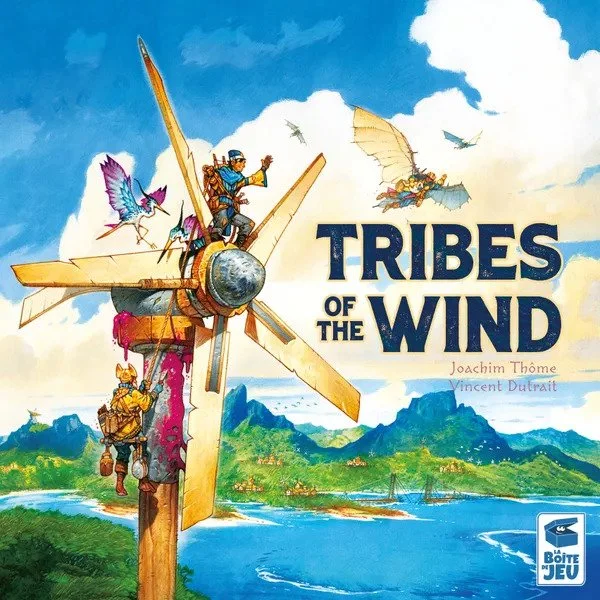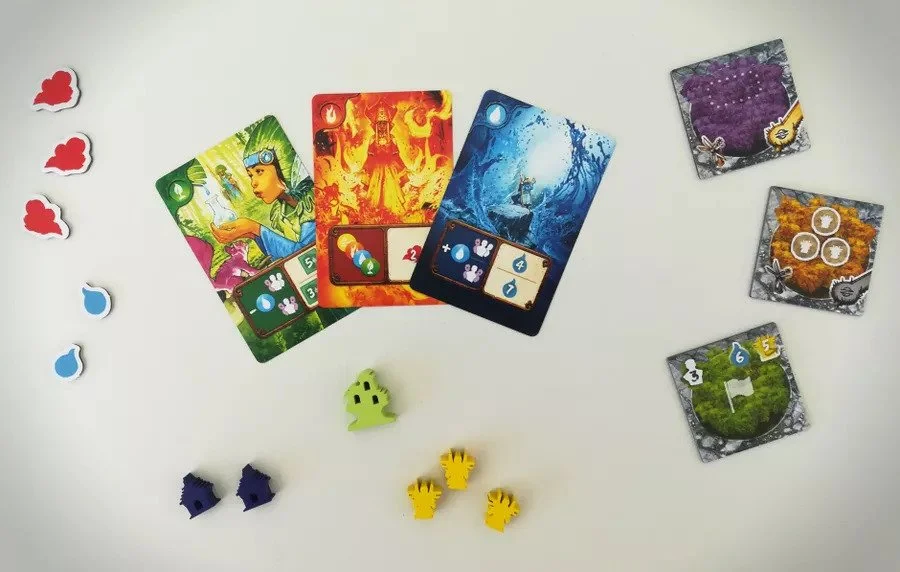Tribes of the Wind, PAX Unplugged, & AGU
It’s been a packed month! While at PAX Unplugged, I squeezed in a game of Tribes of the Wind, a 2-5 player euro-y little thing by Joachim Thôme. This has been on my list – there’s a windmill on the cover, so I’m legally obligated to play it – but I don’t have a whole ton to say about it. So, I thought I’d do a little website & newsletter exclusive post, including scattered musings on PAX Unplugged, Hubworld: Aidalon, Molly House, and my subsequent journey to the American Geophysical Union 2024 Annual Meeting. Come, fly with me.
Tribes of the Wind
You are a Wind Rider, soaring through what remains of a polluted world. You hope to reclaim this wasteland, repopulating the countryside with forests, treetop villages, and temples. Your wingsuit allows for speedy travel between your capital city and the frontier. Along the way, you wield four elemental magics – water, fire, wind, and grass – to restore the landscape to its former glory.
The Haley Board Game Review Promise™ is that I’ll never spend too much time regurgitating mechanics to you. This makes reviewing a game like Tribes of the Wind a challenge. While the theme isn’t haphazardly pasted on, the designer was clearly more focused on the game’s mechanics. As my high school English teacher always said, though, “everything’s an argument;” what is Thôme saying here, intentionally or not? Let’s dive in¹.
The gorgeous box cover, with art by good ol’ Vincent Dutrait. Image credit: Benoit Bannier
Wind-suited humans hanging with brightly colored birds atop a homely wooden windmill? Delightful. There’s something about these emerald mountains and bright blue skies that draws you in. This is a world worth working towards. You scrub the land of old pollution, and it is no terrible chore. You receive victory points for healing the land, whether you end up settling a community there or not. Although I built my fifth and final village before anyone else, triggering the end of the game, I came squarely in last place. My opponents were less focused on expanding their settlements, but they had been better stewards of the land. I hope this messaging would hold up across multiple games. If you take care of the land, it takes care of you, and in this way, all flourishing is mutual².
Each player is restoring their own individual player board. We’re not squabbling over limited resources or territory. The competition here is gentle; one person’s gain is not another person’s loss. This feels as it should. In other competitive climate-y games, each player aims to turn the most profit. Tribes of the Wind, rather, feels like a competitive donation drive between schools; it’s got just a touch of good-natured ribbing attached to inspire more good.
I feel ill-equipped to opine on the usage of “Tribes” in the title, but it leaves me uneasy. The title and art feel generally Indigenous-coded. Indigenous tribes are some of the most capable land stewards around, so the fact that pollution spreads when villages are built³ felt incongruous with the theme. I’m not Indigenous, but I can’t/don’t know if the designer/artists are either, so maybe we’re all our of our lanes.
Does saving the world require me to be friends with this Moses-level sorcerer? Image credit: Benoit Bannier
If your neighbors have certain card types in their hands, you might gain or lose some powers, but I wouldn’t go so far as to call it “player interaction.” If multiplayer solitaire isn’t your bag, don’t be fooled. I’m not even sure how this mechanic gels thematically. I think it has something to do with the barely-explained magic of this world? If your neighbor has a lot of water cards, I suppose there’s less water magic at your disposal. I wish the magic vibes would’ve been cut entirely. I prefer when all aspects of a solarpunk setting seem, hypothetically, within our reach.
All in all, this is a cute little multiplayer solitaire situation. I love a hand-management game; I love a tile placement game; I love a solarpunk theme. I had a good time, and so did the folks I played it with. It would make a great family game; it’s not going to blow anyone’s mind. The production seems par for the course. We’ve got FSC-mix paper, and the game is designed without plastic (save for the card coatings, I’m guessing). Give it a go if you get the chance. I also recommend Wild Space, another Joachim Thôme design I quite enjoyed back in 2021.
PAX Unplugged
Board gaming is a niche hobby that can occasionally feel lonely. To converge on a place with thirty thousand other board game enthusiasts, then, was a blast. I got to meet and/or chat with so many lovely folks, including the Earthborne Games team, Tom and Matt from Shut Up & Sit Down, Elizabeth Hargrave, Root expansion designer Joshua Yearsley, SungWon Cho (ProZD), and more. I’ve been chatting with folks online in the Earthborne Games Discord server for years, and I got to meet many of them in person for the first time. Truly, a treat!
Hubworld: Aidalon temporary box art. Image credit: Earthborne Games
I played a single demo of Hubworld: Aidalon, Earthborne Games’ next title designed by Cory DeVore and Michael Boggs. The planet Aidalon was, once upon a time, a transportation hub for the galaxy. Now, though, the Collective has brought in their new-fangled portal technology, rendering Aidalon mostly obsolete. Players are skulking around the planet’s black market to make a living.
When I described this theme to a friend, he joked, “Finally — someone’s made a game about Detroit!”⁴ But Hubworld: Aidalon is not a caricature of poverty. It feels authentic and alive, filled with folks doing their honest best to get by after being dealt a bad hand.
Hubworld: Aidalon has been branded as an “Android: Netrunner, but better” situation. I’m not a Netrunner player, so I can’t speak to its similarity, but I can say that I had a good time. If you’re into Magic or other card duelers, it will scratch the itch. Placing cards face-down into a three-by-three grid allows for a wider decision space than constructing a deck and mindlessly watching cardboard go “brrrrrrr.” Planting these face-down cards really does feel like scheming and setting clever traps for your opponent.
I’ll be sure to back this one on Gamefound once the campaign launches. I’ll report back once I’ve got the finished product in my hands!
Molly House box cover. Image credit: Cole Wehrle
I also played most of a game of Molly House, designed by Jo Kelly and Cole Wehrle of Wehrlegig Games. I quite enjoyed this. The theming is spot-on and handled with great care. You play as genderqueer “mollies” in 16th century London, building community and evading the ire of the Society for the Reformation of Manners. This Society wishes to stamp out the queer community and its gathering spaces. Players want to be loudly and joyfully queer with their friends, but they can also throw each other under the bus to evade trouble with the cops. In a world where queerness is violently weaponized in political rhetoric and misrepresented as some “new fad,” it is refreshing to see real genderqueer people from hundreds of years ago given time in the spotlight. I found the game striking some hopeful chords for me. Despite hundreds of years of efforts to eradicate them, queer communities have always existed and found joy in togetherness. Together, we persist.
The game itself is great. It’s got solid trick-taking bones. The mention of roll-and-move mechanics gave me the ick at first, but it feels much more like action selection or worker placement in practice. We didn’t make it to the late game, where betrayal would become more of an option – perhaps the game would not feel so hopeful if I had finished it out – but I could glimpse the narrative and strategic depth those mechanics have to offer.
AGU
After two long and full days at PAX Unplugged, I hopped on a bus for three hours. The whole reason I went to PAX was because it was proximal to the 2024 Annual Meeting of the American Geophysical Union (AGU) in Washington, D.C. AGU is a professional society for geoscientists. I was fortunate for my trip out to be supported by the AGU Voices for Science program. As a Voice for Science, I am supported in a number of science communication side quests, including stuff like writing this blog and K-12 climate outreach efforts.
In my day job, I study extreme heat and its impacts on human health. I spend a lot of time thinking about how people sweat⁵ and otherwise cool themselves down. The details are a post for another day; since I’ve published exactly zero academic papers as of yet, I assume most folks currently on my website or subscribed to my newsletter are here for the board games. Once I get my sea legs under me, I’ll post more about my science – but for now, games.
AGU is a highly interdisciplinary community. While there are plenty of “traditional” geoscientists there to show off their work, there’s also a large community of science communicators and educators. I was downright gleeful to find posters and talks on games and gamification for climate education there.
It’s an interesting space to be in. There are a lot of climate educators – many of them old and seasoned, many of them non-gamers – who see the potential for games to make a massive climate impact. They see younger generations captivated by screens and games, and they want a piece of that magic. It seems to me that there’s a hell of a lot of people designing educational climate games with little or no experience in game design. That’s not to say these games aren’t good – I think many of them are. And, shoot, maybe these folks do have experience in game design – I didn’t get to talk to everyone. But I think a lot of these climate games are being designed for captive young audiences in classrooms. Most of these games, with few glaring exceptions like Daybreak, will never have widespread appeal.
When educators realize I know what’s trendy in the board game mainstream, they’re eager to hear what I think works for a broader audience. There is a real desire to bring these games to more folks, but not nearly enough resources to make that happen. How can we get these games onto more tables – even if that just means more classrooms?
A good place to start is identifying what these games even are, and where you can get them. David Blockstein at Bard University is spearheading the first Worldwide Climate Education Week during April 7-13, 2025, with April 11 specifically being Worldwide Climate and Justice Games Day. As part of this effort, the team is putting together a database of climate games. Got any ideas to add to this list? Submit your favorite game through their Google Form. I hope this database becomes a great repository, and I hope Worldwide Climate Education Week becomes a yearly tradition!
This is only the beginning. I hope I don’t need to convince you of all people, dear reader, of the power of games to change the world. The best learning is tactile, collaborative, and engaging. But what happens when climate games actually make it to the table? Do our dreams come to fruition? Can games really shape our climate future? Join me next time to hear about Energetic, a game about decarbonizing New York City that has been deployed in dozens of NYC high school classrooms. Together, we’ll find out if thousands of gen alpha kids didn’t have the attention span to learn anything from a two-hour board game, or if Energetic might really change kids’ hearts, minds, and career paths.
I’m not making content on any regular schedule – finishing my PhD is my top priority – so instead of a Patreon, I’ve opted to start a Ko-Fi. I’m not trying to earn enough money to make a living from this, but if you buy me a coffee, maybe I’ll save the world a little faster. You can also sign up for my email newsletter to be notified when I do another review (or cool science).
Footnotes
Be sure to exit your dive with plenty of room to spare. These wingsuits are not easy to replace if you crash them.
If you haven’t heard that all flourishing is mutual – that is, if you haven’t read Braiding Sweetgrass by Robin Wall Kimmerer yet – what are you waiting for? This book is the antidote to climate despair.
Not all – tiles with a windmill on them will not cause pollution to spread when a village is built on them. I’m not sure how many of these tiles are in the game.
This, of course, is not Detroit’s full story — check out the Detroitology episode of my favorite podcast, Ologies with Alie Ward.
I unfortunately thought a lot about sweat at PAX Unplugged, too.



